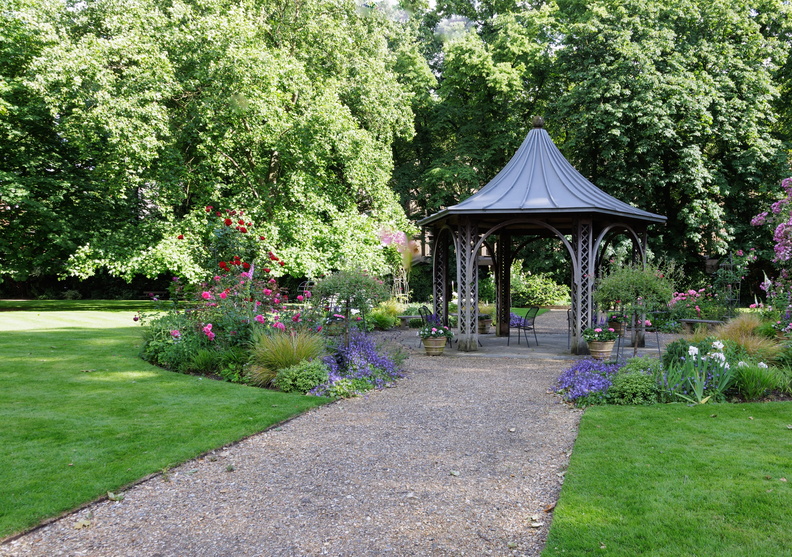Royal Crescent Gardens (Kensington & Chelsea)
Brief Description
The private communal garden was provided for residents of Royal Crescent, which was built as part of the development of the Norland Estate. The estate, which originally comprised 52 acres of grounds attached to Norland House, passed through various owners until William Kingdom purchased it for house development in the late 1830s. In 1997 the perimeter railings were replaced and in 2003 work began to re-design the gardens. The new landscaping scheme retains its overall feel, adding a central gazebo, renewing planting and paths. Many of the trees date from the C19th, with two large London planes that may predate the original layout.
Practical Information
- Previous / Other name:
- Norland Crescent
- Site location:
- Royal Crescent/Holland Park Avenue
- Postcode:
- W11 4SN
- What 3 Words:
- drives.commented.oppose
- Type of site:
- Garden Square
- Borough:
- Kensington & Chelsea
- Open to public?
- Occasionally
- Opening times:
- Has opened for OGSW. Otherwise private, keyholders only
Has taken part in Open Garden Squares Weekend 26 times, most recently in 2025. - Special conditions:
- Facilities:
- Events:
- Public transport:
- Tube: Holland Park (Central), Shepherd's Bush Market (Hammersmith and City). Rail/London Overground/Tube (Central): Shepherd's Bush. Bus: C1, 31, 49, 94, 148, 295, 316
- Research updated:
- 01/02/2010
- Last minor changes:
- 19/07/2023
Please check with the site owner or manager for latest news.
Full Site Description
Royal Crescent is part of the Norland Estate, which was developed from c.1840. The Estate was originally 52 acres of grounds attached to Norland House, the site of the house now No. 130 Holland Park Avenue. The name 'Norlands' appears in records in 1599 and in the early C18th Norland House was purchased by Thomas Greene, whose grandson E B Greene inherited in 1740. However, due to debts, Greene was forced to lease the house and 12 acres as a military academy in 1761. When he died in 1791 the estate was bought at auction by Benjamin Vulliamy, whose family held it until 1839. Vulliamy then sold Norland to William Kingdom for development. He was encouraged by the acceleration of building development in the area, the Ladbroke Estate to the east and the Holland Estate to the south, together with much-improved drainage of the land due to a new sewer built in 1838/9 through the estate to accommodate the Birmingham, Bristol and Thames Junction Railway line. Kingdom assigned the sale of the estate to solicitor Charles Richardson, who then began raising the necessary capital to build 3 miles of sewers approved by the Westminster Commissioner of Sewers and to begin building the estate to designs by Kingdom's architect Robert Cantwell. Building progress did not go smoothly and despite his best efforts Richardson was bankrupt by 1855. By 1850 Royal Crescent was still incomplete.
In the 1860s the OS map showed that the crescent garden was laid out with a path around the semi-circular periphery and many winding paths within the space. The garden was for the use of rated inhabitants of the Crescent, and were maintained by a Garden Committee out of rates levied by the Borough Council. The Report of the Royal Commission on London Squares (1928) commented that: 'Since the garden is a safe and healthy resort for children and elderly people, and since it is a beautiful oasis in an otherwise sordid neighbourhood, it would be very undesirable to close it'. At that time it was surrounded by privet hedge and was 'a large and attractive open space laid out as an ornamental garden with lawns, shrubberies, etc. Contains some fine trees.'
Today the path layout of the 1860s have gone and there is open grass in the centre and trees and shrubs around the edge. The original railings were removed in 1941 and sold for £62 for the war effort and the garden was enclosed with chain link fencing until 1997. The Garden Committee then succeeded in raising the necessary funds to commission new railings from architect Susan Walker, which have since won an RBKC Environment Award. In 2003 the Garden Committee began work on re-designing the garden and garden designer Diana Ward was engaged to work with the Committee. The new scheme retained the overall ambiance of the garden, adding a new central gazebo, and renewing planting and paths. Among the trees are a number dating from the C19th, with two large planes that may predate its layout. In 2007 the garden won the Kensington Society Award for Garden Design, and in 2008 first prize for communal gardens in North Kensington under the Brighter Kensington and Chelsea Scheme.
Sources consulted:
Survey of London; RBKC Norland Conservation Area Policy Statement, 1989, Report of Royal Commission on London Squares, 1928
Further Information (Planning and Conservation)
- Grid ref:
- TQ240800 (524049,180020)
- Size in hectares:
- 0.799
- Site ownership:
- private
- Site management:
- Royal Crescent Gardens Committee, contract gardeners Joseph Jones
- Date(s):
- 1846
- Designer(s):
- Robert Cantwell (overall layout of estate). 2003: Diana Ward
- Listed structures:
- LBII*: 1- 6; 7- 44 Royal Crescent
- On National Heritage List for England (NHLE), Parks & Gardens:
No- Registered common or village green on Commons Registration Act 1965:
No- Protected under London Squares Preservation Act 1931:
Yes
Local Authority Data
The information below is taken from the relevant Local Authority's planning legislation, which was correct at the time of research but may have been amended in the interim. Please check with the Local Authority for latest planning information.
- On Local List:
- No
- In Conservation Area:
- Yes
- Conservation Area name:
- Norland
- Tree Preservation Order:
- Not known
- Nature Conservation Area:
- No
- Green Belt:
- No
- Metropolitan Open Land:
- No
- Special Policy Area:
- No
- Other LA designation:
- None
Photos
Royal Crescent Gardens - Photo: Peter Buckingham
Date taken: 08/06/24 17:23Click a photo to enlarge.
Please note the Inventory and its content are provided for your general information only and are subject to change. It is your responsibility to check the accuracy.





